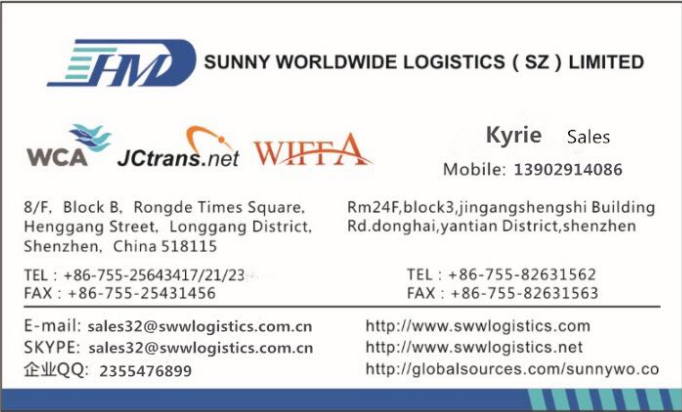How to define dry goods and heavy goods in foreign trade?
- Author:Kyrie
- Source:Search Air
- Release Date:2019-11-29
To understand the definition of bubble and heavy goods, you need to know what is the actual weight, volume weight, and billable weight.
I. Actual weight
Actual Weight, which is the weight obtained according to the weighing (weighing over), including the actual gross weight (G.W.) and the actual net weight (N.W.). The most common is the actual gross weight.
In air cargo transportation, the actual gross weight is often compared with the calculated volume weight, whichever is greater is calculated and charged.
Volume and weight
[Volume weight] Volumetric Weight or Dimensions Weight, that is, the weight calculated from the volume of the cargo according to a certain conversion factor or calculation formula.
In air cargo transportation, the conversion factor for calculating volume and weight is generally 1: 167, that is, one cubic meter is approximately equal to 167 kilograms.
For example: the actual gross weight of a ticket is 95 kg, and the volume is 1.2 cubic meters. According to the coefficient of 1: 167, the volume weight of this ticket is 1.2 * 167 = 200.4 kg, which is greater than the actual gross weight of 95 kg. For bubble goods (also known as light cargo, light weight cargo, English name Light Weight Cargo or Light Cargo / Goods or Low Density Cargo or Measurement Cargo), the airline will charge according to the volume weight, not the actual gross weight. Please note that air freight is generally referred to as bubble cargo, and sea freight is generally referred to as light cargo, which is called differently.
Another example: the actual gross weight of an air cargo is 560 kg, and the volume is 1.5CBM. According to the coefficient of 1: 167, the volume weight of this air cargo is 1.5 * 167 = 250.5 kg, which is less than the actual gross weight of 560 kg. For heavy cargo (English name Dead Weight Cargo or Heavy Cargo / Goods or High Density Cargo), the airline will charge according to the actual gross weight, not the volume weight.
In short, according to a certain conversion factor, calculate the volume weight, and then compare the volume weight with the actual weight, whichever is larger will be charged according to that.
Third, the billing weight
[Billing Weight] The English name is Chargeable Weight, referred to as C.W., which is the weight for calculating freight or other incidental charges.
The billing weight is either the actual gross weight or the volume weight. The billing weight = the actual weight VS the volume weight, whichever is greater is used to calculate the shipping cost.

I. Actual weight
Actual Weight, which is the weight obtained according to the weighing (weighing over), including the actual gross weight (G.W.) and the actual net weight (N.W.). The most common is the actual gross weight.
In air cargo transportation, the actual gross weight is often compared with the calculated volume weight, whichever is greater is calculated and charged.
Volume and weight
[Volume weight] Volumetric Weight or Dimensions Weight, that is, the weight calculated from the volume of the cargo according to a certain conversion factor or calculation formula.
In air cargo transportation, the conversion factor for calculating volume and weight is generally 1: 167, that is, one cubic meter is approximately equal to 167 kilograms.
For example: the actual gross weight of a ticket is 95 kg, and the volume is 1.2 cubic meters. According to the coefficient of 1: 167, the volume weight of this ticket is 1.2 * 167 = 200.4 kg, which is greater than the actual gross weight of 95 kg. For bubble goods (also known as light cargo, light weight cargo, English name Light Weight Cargo or Light Cargo / Goods or Low Density Cargo or Measurement Cargo), the airline will charge according to the volume weight, not the actual gross weight. Please note that air freight is generally referred to as bubble cargo, and sea freight is generally referred to as light cargo, which is called differently.
Another example: the actual gross weight of an air cargo is 560 kg, and the volume is 1.5CBM. According to the coefficient of 1: 167, the volume weight of this air cargo is 1.5 * 167 = 250.5 kg, which is less than the actual gross weight of 560 kg. For heavy cargo (English name Dead Weight Cargo or Heavy Cargo / Goods or High Density Cargo), the airline will charge according to the actual gross weight, not the volume weight.
In short, according to a certain conversion factor, calculate the volume weight, and then compare the volume weight with the actual weight, whichever is larger will be charged according to that.
Third, the billing weight
[Billing Weight] The English name is Chargeable Weight, referred to as C.W., which is the weight for calculating freight or other incidental charges.
The billing weight is either the actual gross weight or the volume weight. The billing weight = the actual weight VS the volume weight, whichever is greater is used to calculate the shipping cost.
For international sea / air / express shipping, please contact Sunny Worldwide Logistics Ltd. business Kyrie:

